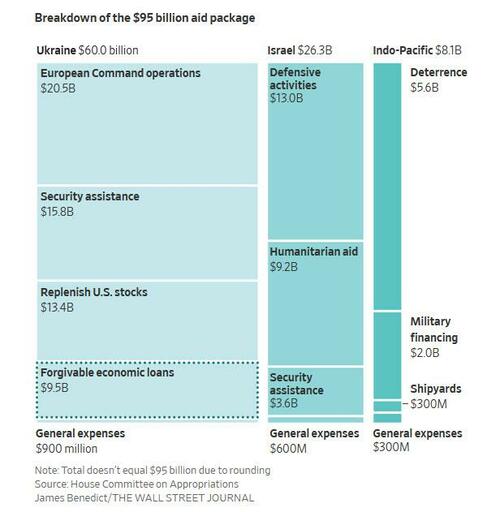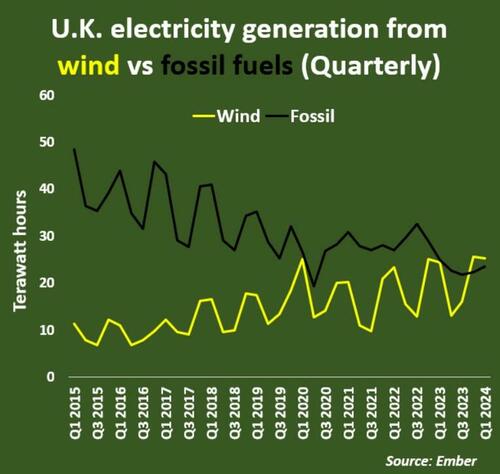Senates Passes $95 Billion Aid Bill For Ukraine, Israel And Taiwan, Forces Sale Of TikTok
The republicans do what they always do best: fold like cheap lawn chairs.
Moments ago, in a 79-18 vote, the Democrat-controlled Senate passed a long-delayed $95.3 billion foreign-aid package sending $60.8 billion in ammunition and military equipment to Ukrainian soldiers, as well as billions of soon-to-be-embezzled dollars to the offshore real estate agents of Ukraine's corrupt oligarchs while also fortifying Israel’s missile defense systems with $26.4 billion, and leaving $8 billion for Taiwan as if that will do anything to stop a Chinese invasion. Oh, and speaking of Chinese invasions, the Senate also just forced the sale of the China-owned TikTok in the U.S.

There will be, of course, no change to the invasion at the southern US border because here too Republicans keep folding like cheap lawn chairs to the Democrat ploy to flood the US with illegal aliens who will get free shit for life if only they keep voting for the blue team.
The bill had broad support in the Senate, with backing from almost all Democrats and a majority of Republicans. Several Republicans who had opposed an earlier iteration of the package, which came after a failed push to attach it to a border-policy overhaul, switched their vote to support Tuesday’s bill. The breakdown of the votes is as follows:
GOP NO VOTES:
- Barrasso
- Blackburn
- Braun
- Budd
- Cruz
- Hagerty
- Hawley
- Johnson
- Lee
- Lummis
- Marshall
- Rubio
- Scott (FL)
- Schmitt
- Vance
DEM NO VOTES:
The vote brought to a close months of pointless sound and fury, and endless debate over Ukraine, that allegedly split the Republican Party, with rank-and-file members openly rebelling against their leaders, who succeeded in outdemocrating the democrats.
The theatrical "fight" also called into question both how far the US would go to defend Ukraine, now in the third year of trying to repel Russia’s invasion, as well as America’s leadership role in the world, once the latest rescue funding is exhausted in a few months, which it will be, with the Ukraine having made zero progress in its war with Russia.
The measure passed the House on Saturday and now goes to President Biden’s desk. Biden, who has been pushing for a big foreign-aid package since the fall, said he would quickly sign the measure into law Wednesday.
As broken down below, the measure contains money for Ukraine, Israel and Taiwan, as well as humanitarian aid for Gaza—largely matching an earlier Senate bill—plus additions made by the House, such as sanctions on Russia and Iran and the TikTok provision. Leaders in the GOP-controlled House also changed roughly $9.5 billion in economic aid to Ukraine into forgivable loans rather than grants, to make it more politically palatable to Republicans, as if Ukraine will ever repay anything.

Senate Majority Leader Chuck Schumer (D., N.Y.) credited the White House as well as Republicans who backed Ukraine for advancing the measure, noting that House Speaker Mike Johnson (R., La.) put his political future on the line when he moved forward with the package.
“In a resounding bipartisan vote, the relentless work of six long months has paid off,” Schumer said on the senate floor. In a statement, Biden thanked lawmakers of both parties, saying they answered “history’s call at this critical inflection point” by sending a message to allies and foes about American power.
And just like that the deeply embedded deep state operative formerly known as the House speaker has become the media's darling overnight:
Of course, while superficially the bill says "aid to Ukraine" where the majority of the money is really going is to the US military industrial complex. As the WSJ reports, the proposal has roughly $60 billion for Ukraine, most of which would flow to the U.S. defense industry for additional weapons such as ammunition and rocket launchers. The new aid comes on top of the more than $100 billion spent on the Defense Industry Kyiv since Russia invaded in February 2022.
And while most muppets in the House and Senate are clearly in the pocket of the military-industrial complex and the deep state, a few holdouts remains.
Sen. Eric Schmitt (R., Mo.), who voted against the measure, called the support for Ukraine to defend its borders “an insult to the American people” while the U.S. struggles with an influx of migrants at its own border with Mexico.
Sen. Ted Cruz (R., Texas) called his opposition to the proposal’s advancement “one of the toughest votes I’ve cast during my years in the Senate,” saying he couldn’t overcome his concern that humanitarian aid would end up in the hands of terrorists, among other worries.
Others were more "malleable" in their ideological beliefs.
Sen. Markwayne Mullin (R., Okla.), who switched from voting against the Senate’s aid package in February to supporting the revised version on Tuesday, said that the politics were complicated. “Our approach this time was to make sure that the politics are set, meaning that President Trump was on board, it’s something that could be passable, it’s something that could be explained,” he said.
Sen. James Lankford (R., Okla.), who also switched his vote, said he didn’t want to “punish Israel and Ukraine” over the lack of border provisions. Lankford had led a failed bipartisan effort to find a compromise on immigration, which was shot down by Republicans earlier this year as not tough enough.
Asked why some Senate Republicans were slow to support aid for Kyiv, 3000-year-old Senate mummy Mitch McConnell cited the “demonization of Ukraine” by conservative political commentator Tucker Carlson. “He had an enormous audience, which convinced a lot of rank and file Republicans that maybe this was a mistake,” McConnell said in a press conference. Carlson declined to comment.
Mummified Mitch also laid blame on former President Donald Trump, Democrats and the border crisis for the amount of time it took to get most Republican lawmakers to acquiesce in continuing to fund the Ukrainian war effort.
“I think the former president had sort of mixed views on it,” he said of Trump’s position on Ukraine aid. “We all felt that the border was a complete disaster, myself included,” McConnell continued, noting that the attempt earlier this year to attach border security provisions to Ukraine funding required senators to “deal with Democrats … and then a number of our members thought it wasn’t good enough.”
“And then our nominee for president didn’t seem to want us to do anything at all,” McConnell said. “That took months to work our way through it.”
Last but not least, the bill also starts the clock on TikTok’s Chinese-controlled owner ByteDance to find a new owner for the video app in the U.S. within a year, or risk a shutdown. But the matter is expected to be decided by the federal courts which means that it will quietly die on some bench in the corrupt US legal system. A court dispute would likely require judges to weigh the national security objectives of the ban against the First Amendment rights of TikTok and its users.
Tyler Durden
Wed, 04/24/2024 - 05:58









Recent comments